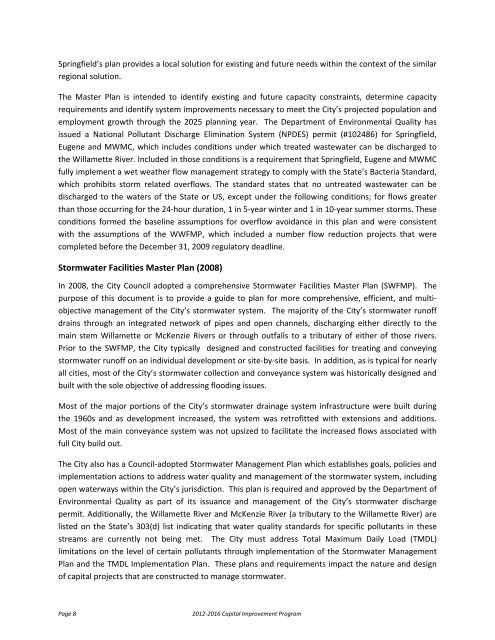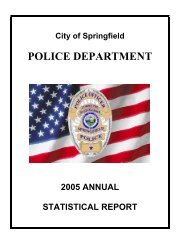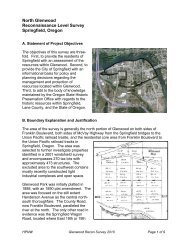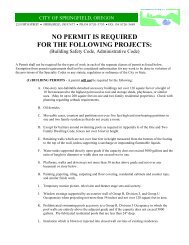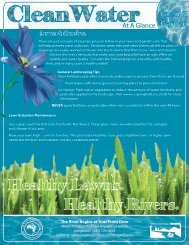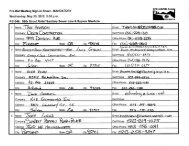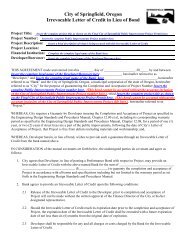WW Project Pages.xlsx - City of Springfield
WW Project Pages.xlsx - City of Springfield
WW Project Pages.xlsx - City of Springfield
Create successful ePaper yourself
Turn your PDF publications into a flip-book with our unique Google optimized e-Paper software.
<strong>Springfield</strong>’s plan provides a local solution for existing and future needs within the context <strong>of</strong> the similarregional solution.The Master Plan is intended to identify existing and future capacity constraints, determine capacityrequirements and identify system improvements necessary to meet the <strong>City</strong>’s projected population andemployment growth through the 2025 planning year. The Department <strong>of</strong> Environmental Quality hasissued a National Pollutant Discharge Elimination System (NPDES) permit (#102486) for <strong>Springfield</strong>,Eugene and MWMC, which includes conditions under which treated wastewater can be discharged tothe Willamette River. Included in those conditions is a requirement that <strong>Springfield</strong>, Eugene and MWMCfully implement a wet weather flow management strategy to comply with the State’s Bacteria Standard,which prohibits storm related overflows. The standard states that no untreated wastewater can bedischarged to the waters <strong>of</strong> the State or US, except under the following conditions; for flows greaterthan those occurring for the 24‐hour duration, 1 in 5‐year winter and 1 in 10‐year summer storms. Theseconditions formed the baseline assumptions for overflow avoidance in this plan and were consistentwith the assumptions <strong>of</strong> the <strong>WW</strong>FMP, which included a number flow reduction projects that werecompleted before the December 31, 2009 regulatory deadline.Stormwater Facilities Master Plan (2008)In 2008, the <strong>City</strong> Council adopted a comprehensive Stormwater Facilities Master Plan (SWFMP). Thepurpose <strong>of</strong> this document is to provide a guide to plan for more comprehensive, efficient, and multiobjectivemanagement <strong>of</strong> the <strong>City</strong>’s stormwater system. The majority <strong>of</strong> the <strong>City</strong>’s stormwater run<strong>of</strong>fdrains through an integrated network <strong>of</strong> pipes and open channels, discharging either directly to themain stem Willamette or McKenzie Rivers or through outfalls to a tributary <strong>of</strong> either <strong>of</strong> those rivers.Prior to the SWFMP, the <strong>City</strong> typically designed and constructed facilities for treating and conveyingstormwater run<strong>of</strong>f on an individual development or site‐by‐site basis. In addition, as is typical for nearlyall cities, most <strong>of</strong> the <strong>City</strong>’s stormwater collection and conveyance system was historically designed andbuilt with the sole objective <strong>of</strong> addressing flooding issues.Most <strong>of</strong> the major portions <strong>of</strong> the <strong>City</strong>’s stormwater drainage system infrastructure were built duringthe 1960s and as development increased, the system was retr<strong>of</strong>itted with extensions and additions.Most <strong>of</strong> the main conveyance system was not upsized to facilitate the increased flows associated withfull <strong>City</strong> build out.The <strong>City</strong> also has a Council‐adopted Stormwater Management Plan which establishes goals, policies andimplementation actions to address water quality and management <strong>of</strong> the stormwater system, includingopen waterways within the <strong>City</strong>’s jurisdiction. This plan is required and approved by the Department <strong>of</strong>Environmental Quality as part <strong>of</strong> its issuance and management <strong>of</strong> the <strong>City</strong>’s stormwater dischargepermit. Additionally, the Willamette River and McKenzie River (a tributary to the Willamette River) arelisted on the State’s 303(d) list indicating that water quality standards for specific pollutants in thesestreams are currently not being met. The <strong>City</strong> must address Total Maximum Daily Load (TMDL)limitations on the level <strong>of</strong> certain pollutants through implementation <strong>of</strong> the Stormwater ManagementPlan and the TMDL Implementation Plan. These plans and requirements impact the nature and design<strong>of</strong> capital projects that are constructed to manage stormwater.Page 82012-2016 Capital Improvement Program


